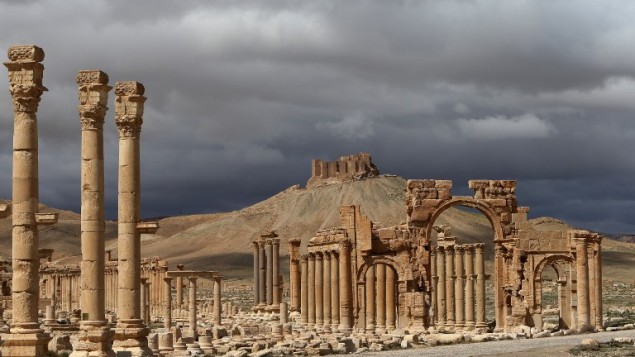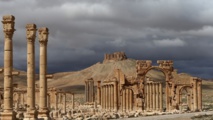The UN's cultural watchdog called it an "intolerable crime against civilisation".
Dozens of relics remain at risk in the ruins of Palmyra, which IS jihadists seized from regime forces in May as they pursued their campaign for territory in Syria and Iraq.
The extremist group's harsh philosophy condemns pre-Islamic religious sites and considers statues and grave markers to be idolatrous, but it has also been accused of destroying heritage to loot items for the black market and to gain publicity.
Satellite images taken before and after an explosion at Palmyra on Sunday "confirm the destruction of the main Temple of Bel as well as a row of columns in its immediate vicinity," UN training and research agency UNITAR said.
The 2,000-year-old temple was the centrepiece of Palmyra's famed ruins and one of the most important relics at the UNESCO-listed heritage site.
"The Temple of Bel was the most beautiful symbol of all of Syria. It was the most beautiful place to visit," Syrian antiquities director Maamoun Abdulkarim told AFP by telephone from Damascus.
"And we have lost it forever."
IS fighters seized Palmyra from Syrian regime forces on May 21.
While antiquities staff evacuated most of the city's museum before IS arrived, the group destroyed an ornate lion statue outside the building and also mined Palmyra's ruins.
Last month the jihadists beheaded the 82-year old former antiquities chief in Palmyra and destroyed the ancient shrine of Baal Shamin.
- 'They have killed Palmyra' -
On Sunday, activists and a monitor reported a large explosion at the site had destroyed the Temple of Bel.
Abdulkarim said Palmyra's remaining ruins include "dozens of the greatest grave markers, the amphitheatre, and the Temple of Nabu, which only has its foundations."
The city's grand Roman amphitheatre, which dates from between the second and third century, is not believed to have been damaged.
But it was the scene of a gruesome massacre shortly after IS seized Palmyra, with child members of the group killing 25 soldiers.
"They have killed Palmyra. Now, they will terrorise it," Abdulkarim said. "It's the last warning before the complete destruction of Palmyra."
Cheikhmous Ali of the Association for the Protection of Syrian Archeology described the razing of the ruins as "a way to pressure and torture the local population -- to suppress their history and their collective memory."
It was also an attempt to "remain in the headlines", he said, warning: "The more we give IS's savage actions media attention, the more they will repeat this."
UNESCO chief Irina Bokova expressed "deep distress" over the temple's destruction, but vowed it would "not erase 4,500 years of history".
Washington added its voice to the chorus of condemnation and warned countries and individuals against supporting IS by trafficking and selling looted Syrian treasures.
"All those who destroy important cultural property must be held accountable," said State Department spokesman Mark Toner.
- 'Symbolic power' in destruction -
Gruesome violence and the destruction of priceless artefacts have become hallmarks of IS as it expands its so-called "caliphate" straddling Iraq and Syria.
In addition to damaging sites in Syria, IS has destroyed statues, shrines, and manuscripts in the Iraqi city of Mosul, and demolished the ancient Assyrian city of Nimrud.
Charlie Winter, an analyst with the London-based Quilliam Foundation, said the destruction "makes sense with the jihadist worldview, because these temples are symbols of polytheism."
"They are pre-Islamic and are considered by IS not to be worthy of existence," Winter said.
He agreed IS may be seeking to reclaim headlines at a time when its gruesome killings no longer receive the same media attention as before.
The militants have used sophisticated media techniques to gain publicity and lure thousands of foreigners to join their ranks.
"The videos IS publishes of people being burned alive don't grab headlines anywhere near as much as headlines about Palmyra do," Winter said.
IS "has recognised the symbolic power of destroying these ruins.
"If there's anything IS revels in, it's condemnation" of its actions, he said.
Regime forces have launched an offensive to retake the ancient city and as they edge closer the jihadist group may be looking to sow as much destruction as it can.
"The more likely it looks that IS will end up losing Palmyra, the more likely it will destroy what's left there," Winter said.
--------------------------------------------------------------------------------------------------
Dozens of relics remain at risk in the ruins of Palmyra, which IS jihadists seized from regime forces in May as they pursued their campaign for territory in Syria and Iraq.
The extremist group's harsh philosophy condemns pre-Islamic religious sites and considers statues and grave markers to be idolatrous, but it has also been accused of destroying heritage to loot items for the black market and to gain publicity.
Satellite images taken before and after an explosion at Palmyra on Sunday "confirm the destruction of the main Temple of Bel as well as a row of columns in its immediate vicinity," UN training and research agency UNITAR said.
The 2,000-year-old temple was the centrepiece of Palmyra's famed ruins and one of the most important relics at the UNESCO-listed heritage site.
"The Temple of Bel was the most beautiful symbol of all of Syria. It was the most beautiful place to visit," Syrian antiquities director Maamoun Abdulkarim told AFP by telephone from Damascus.
"And we have lost it forever."
IS fighters seized Palmyra from Syrian regime forces on May 21.
While antiquities staff evacuated most of the city's museum before IS arrived, the group destroyed an ornate lion statue outside the building and also mined Palmyra's ruins.
Last month the jihadists beheaded the 82-year old former antiquities chief in Palmyra and destroyed the ancient shrine of Baal Shamin.
- 'They have killed Palmyra' -
On Sunday, activists and a monitor reported a large explosion at the site had destroyed the Temple of Bel.
Abdulkarim said Palmyra's remaining ruins include "dozens of the greatest grave markers, the amphitheatre, and the Temple of Nabu, which only has its foundations."
The city's grand Roman amphitheatre, which dates from between the second and third century, is not believed to have been damaged.
But it was the scene of a gruesome massacre shortly after IS seized Palmyra, with child members of the group killing 25 soldiers.
"They have killed Palmyra. Now, they will terrorise it," Abdulkarim said. "It's the last warning before the complete destruction of Palmyra."
Cheikhmous Ali of the Association for the Protection of Syrian Archeology described the razing of the ruins as "a way to pressure and torture the local population -- to suppress their history and their collective memory."
It was also an attempt to "remain in the headlines", he said, warning: "The more we give IS's savage actions media attention, the more they will repeat this."
UNESCO chief Irina Bokova expressed "deep distress" over the temple's destruction, but vowed it would "not erase 4,500 years of history".
Washington added its voice to the chorus of condemnation and warned countries and individuals against supporting IS by trafficking and selling looted Syrian treasures.
"All those who destroy important cultural property must be held accountable," said State Department spokesman Mark Toner.
- 'Symbolic power' in destruction -
Gruesome violence and the destruction of priceless artefacts have become hallmarks of IS as it expands its so-called "caliphate" straddling Iraq and Syria.
In addition to damaging sites in Syria, IS has destroyed statues, shrines, and manuscripts in the Iraqi city of Mosul, and demolished the ancient Assyrian city of Nimrud.
Charlie Winter, an analyst with the London-based Quilliam Foundation, said the destruction "makes sense with the jihadist worldview, because these temples are symbols of polytheism."
"They are pre-Islamic and are considered by IS not to be worthy of existence," Winter said.
He agreed IS may be seeking to reclaim headlines at a time when its gruesome killings no longer receive the same media attention as before.
The militants have used sophisticated media techniques to gain publicity and lure thousands of foreigners to join their ranks.
"The videos IS publishes of people being burned alive don't grab headlines anywhere near as much as headlines about Palmyra do," Winter said.
IS "has recognised the symbolic power of destroying these ruins.
"If there's anything IS revels in, it's condemnation" of its actions, he said.
Regime forces have launched an offensive to retake the ancient city and as they edge closer the jihadist group may be looking to sow as much destruction as it can.
"The more likely it looks that IS will end up losing Palmyra, the more likely it will destroy what's left there," Winter said.
--------------------------------------------------------------------------------------------------









 Home
Home Politics
Politics











